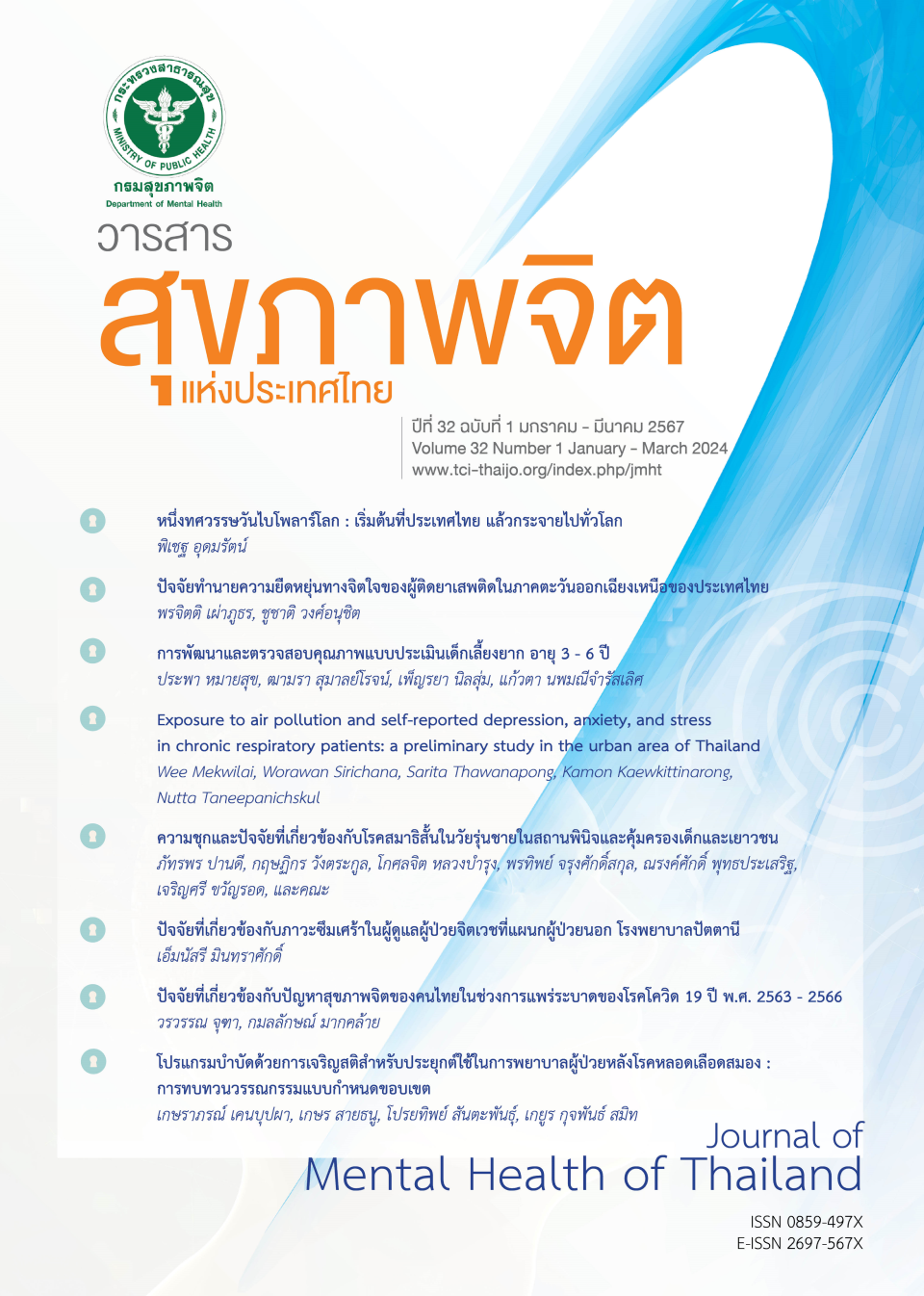การพัฒนาและตรวจสอบคุณภาพแบบประเมินเด็กเลี้ยงยาก อายุ 3 - 6 ปี
คำสำคัญ:
แบบประเมิน, คุณสมบัติการวัดทางจิตวิทยา, เด็กปฐมวัย, เด็กเลี้ยงยากบทคัดย่อ
วัตถุประสงค์ : เพื่อพัฒนาและตรวจคุณภาพของแบบประเมินเด็กเลี้ยงยาก อายุ 3 - 6 ปี
วิธีการ : พัฒนาแบบประเมินโดยอิงทฤษฎีพัฒนาการอารมณ์สังคมและพัฒนาการทางระบบประสาท ตรวจสอบความตรงเชิงเนื้อหาด้วยการหาดัชนีความสอดคล้องจากผู้เชี่ยวชาญ 5 คน ตรวจสอบความเชื่อมั่นโดยการหาค่าสัมประสิทธิ์แอลฟาของครอนบาคและสหสัมพันธ์ระหว่างคะแนนรายข้อกับคะแนนรวม ตรวจสอบความคงที่ของแบบประเมินด้วยวิธีทดสอบซ้ำ และตรวจสอบความตรงเชิงโครงสร้างโดยการวิเคราะห์องค์ประกอบเชิงยืนยันในกลุ่มพ่อแม่หรือผู้ดูแลหลักของเด็กปฐมวัยอายุ 3 - 6 ปี
ผล : แบบประเมินฉบับร่าง 50 ข้อ มีองค์ประกอบ 6 ด้าน ประกอบด้วยลักษณะเด็กเลี้ยงง่าย เด็กอ่อนไหว เด็กเก็บตัว เด็กท้าทาย เด็กเหม่อลอย และเด็กมากพลัง มีดัชนีความสอดคล้องระหว่าง 0.6 - 1.00 ค่าสัมประสิทธิ์สหสัมพันธ์ระหว่างคะแนนรายข้อกับคะแนนรวมระหว่าง 0.28 - 0.81 และค่าสัมประสิทธิ์สหสัมพันธ์ของเพียร์สันจากวิธีทดสอบซ้ำระหว่าง 0.60 - 0.89 (p < .001) การทดสอบในกลุ่มตัวอย่าง 367 คน พบว่า มี 33 ข้อที่ผ่านเกณฑ์การวิเคราะห์องค์ประกอบเชิงยืนยัน โดยมีค่าสัมประสิทธิ์แอลฟาของครอนบาคทั้งฉบับ 0.83 และรายองค์ประกอบระหว่าง 0.72 - 0.91
สรุป : แบบประเมินเด็กเลี้ยงยากที่พัฒนาขึ้นมีคุณสมบัติการวัดทางจิตวิทยาที่เหมาะสม โดยมีความเชื่อมั่นอยู่ในเกณฑ์ที่ดีและมีความสอดคล้องภายในสูง
Downloads
เอกสารอ้างอิง
Teekavanich S, Chantaratin S, Sirisakpanit S, Tarugsa J. Prevalence and factors related to behavioral and emotional problems among preschool children in Bangkok, Thailand. J Med Assoc Thai. 2017;100(2):175-82.
Poulou MS. Emotional and behavioural difficulties in preschool. J Child Fam Stud. 2015;24(2):225-36. doi:10.1007/s10826-013-9828-9.
Greenspan SI. The challenging child: understanding, raising, and enjoying the five “difficult” types of children. Boston: Da Capo Press; 1995.
Thomas A, Chess S. Temperament and development. Brunner: American Psychological Association; 1977.
Tripathi S. The digital youth’s personality and conscience versul their vision adjustment. Journal of Early Childhood Education Management. 2019;1(1):90-100.
Thomasgard M. Working with challenging young children: relations between child temperament, response to novelty and sensory processing. Clin Pediatr (Phila). 2003;42(3):197-204. doi:10.1177/000992280304200302.
Saricelik S, Saban A. Classroom teachers’ perceptions of difficult children: a phenomenological study. Journal of Qualitative Research in Education. 2021;9(25):1-27. doi:10.14689/enad.25.1.
Li I, Shen PS, Wu ML, Wang W. The relationship between preschoolers’ sensory regulation and temperament: implications for parents and early childhood caregivers. Early Child Dev Care. 2022;192(1):1-11. doi:10.1080/03004430.2020.1853116.
Siriumpunkul P, Lerthattasilp T, Sungthong C, Keebang J. The development of the temperament promotion model among the difficultly children in early childhood. Bangkok: National Research Council of Thailand; 2018.
Deepaen S. The effects of a program for parents responding to children with difficult temperament on the temperament of preschool children [master’s thesis]. Pathum Thani: Thammasat University; 2018.
Siriumpunkul P, Keebang J. Temperament and related factors in early childhood. Journal of Mental Health of Thailand. 2021;29(1):80-92.
Comrey A., Lee H. A first course in factor analysis. New Jersey: Lawrence Erlbaum; 1992.
Greenspan SI, Wieder S. The interdisciplinary council on developmental and learning disorders diagnostic manual for infants and young children - an overview. J Can Acad Child Adolesc Psychiatry. 2008;17(2):76-89.
Gravetter, FJ, and Larry BW. Essentials of Statistics for the Behavioral Science. 7th ed. Wadsworth Publishing Company; 2008.
Fitzner K. Reliability and validity: a quick review. New York: Diabetes Educ; 2007.
Phattharayuttawa S. Manual of psychological testing. 5th ed. Bangkok: Medical Media; 2013.
Hair Jr JF, Anderson RE, Tatham RL, Black WC. Multivariate data analysis with readings. 4th ed. New Jersy: Prentice Hall; 1995.
Angsuchoti S. The use of factor analysis for instrument development in behavioral sciences. Sripatum Review of Humanities and Social Sciences. 2015;15(1):125-35.
Taherdoost H, Sahibuddin S, Jalaliyoon N. Exploratory Factor Analysis; Concepts and Theory. Advances in Applied and Pure Mathematics. 2022;27:375-82.
Pasunon P. Reliability of questionnaire in quantitative research. Parichart Journal. 2014;27(1):144-63.
Suktawee P, Koolnaphadol P, Hengudomsub P. Parenting skills enhancement for children in digital age through innovative contemporary family counselling. Journal of Educational Research. 2023;18(1):178-90.
Kochanova K, Pittman LD, McNeela L. Parenting stress and child externalizing and internalizing problems among low-income families: exploring transactional associations. Child Psychiatry Hum Dev. 2022;53(1):76-88. doi:10.1007/s10578-020-01115-0.
Trumello C, Ballarotto G, Ricciardi P, Paciello M, Marino V, Morelli M, et al. Mothers and fathers of pre-school children: a study on parenting stress and child's emotional-behavioral difficulties. Curr Psychol. 2022:1-12. doi:10.1007/s12144-022-03599-6.
ดาวน์โหลด
เผยแพร่แล้ว
รูปแบบการอ้างอิง
ฉบับ
ประเภทบทความ
สัญญาอนุญาต
ลิขสิทธิ์ (c) 2024 วารสารสุขภาพจิตแห่งประเทศไทย

อนุญาตภายใต้เงื่อนไข Creative Commons Attribution-NonCommercial-NoDerivatives 4.0 International License.
- ผู้อ่านสามารถนำข้อความ ข้อมูล จากวารสารไปใช้ไปใช้ประโยชน์ทางวิชาการได้ เช่น เพื่อการสอน เพื่อการอ้างอิง แต่การนำไปใช้เพื่อวัตถุประสงค์อื่น เช่น เพื่อการค้า จะต้องได้รับอนุญาตเป็นลายลักษณ์อักษรจากกรมสุขภาพจิตก่อน
- ความคิดเห็น ข้อมูล และบทสรุปต่าง ๆ ที่ลงตีพิมพ์ในวารสารสุขภาพจิตแห่งประเทศไทยเป็นของผู้เขียนบทความและมิได้แสดงว่ากองบรรณาธิการหรือกรมสุขภาพจิตเห็นพ้องด้วย




